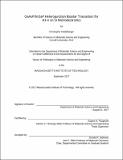GaAsP/InGaP heterojunction bipolar transistors for III-V on Si microelectronics
Author(s)
Heidelberger, Christopher
DownloadFull printable version (3.860Mb)
Other Contributors
Massachusetts Institute of Technology. Department of Materials Science and Engineering.
Advisor
Eugene A. Fitzgerald.
Terms of use
Metadata
Show full item recordAbstract
GaAs-based transistors are capable of operating at high frequency with low noise, and are produced in large volumes for a wide range of applications including microwave frequency ICs for input/output in mobile devices. However, Si CMOS still holds an advantage for digital logic due to wide market penetration resulting in decades of development and lower cost. Monolithic integration of III-V analog circuity and Si CMOS gives circuit designers the best of both materials. In addition, by substituting GaAsxP₁-x (0.8 < x < 1) for GaAs as an active material, we can take advantage of its higher breakdown voltage and reduced lattice mismatch with Si. In this thesis, we study GaAsP/InGaP heterojunction bipolar transistors (HBTs) grown via MOCVD as a test-bed for III-V microelectronics integration with Si. Epitaxial challenges involving growth of GaAsP/InGaP HBT structures on Si substrates were addressed. Heavy C p-type doping of GaAsP via MOCVD, necessary for the HBT base region, was studied. Growth rate, composition, and hole concentration dependence on C precursor (CBrCl₃) input was investigated, yielding GaAsP films with hole concentrations in excess of 2 x 10¹⁹ cm-³. GaAs₀₈₂₅P was grown on Si substrates via a SiGe graded buffer with a threading dislocation density of 3.7 x 106 cm-2 measured by PV-TEM and EBIC. This density is appropriate for fabrication of minority-carrier devices such as HBTs. GaAsP/InGaP HBTs were fabricated on both GaAs and Si substrates with a range of defect densities to measure the effect on DC performance and prove the feasibility of GaAsP transistor growth on Si. Models for the effect of threading dislocation density and misfit dislocation density (in the active device layers) on current gain were developed. A GaAsP/InGaP HBT grown on Si was demonstrated with a current gain as high as 158. Changes in GaAsxP₁-x composition from 0.825 < x < 1 did not have a significant effect on current gain. Collector current was determined not to be controlled by thermionic emission of electrons from the emitter into the base, contrary to prior reports. In addition, GaAsP was shown to support a higher breakdown voltage than GaAs, consistent with modeling.
Description
Thesis: Ph. D., Massachusetts Institute of Technology, Department of Materials Science and Engineering, 2017. This electronic version was submitted by the student author. The certified thesis is available in the Institute Archives and Special Collections. Cataloged from student-submitted PDF version of thesis. Includes bibliographical references (pages 129-140).
Date issued
2017Department
Massachusetts Institute of Technology. Department of Materials Science and EngineeringPublisher
Massachusetts Institute of Technology
Keywords
Materials Science and Engineering.